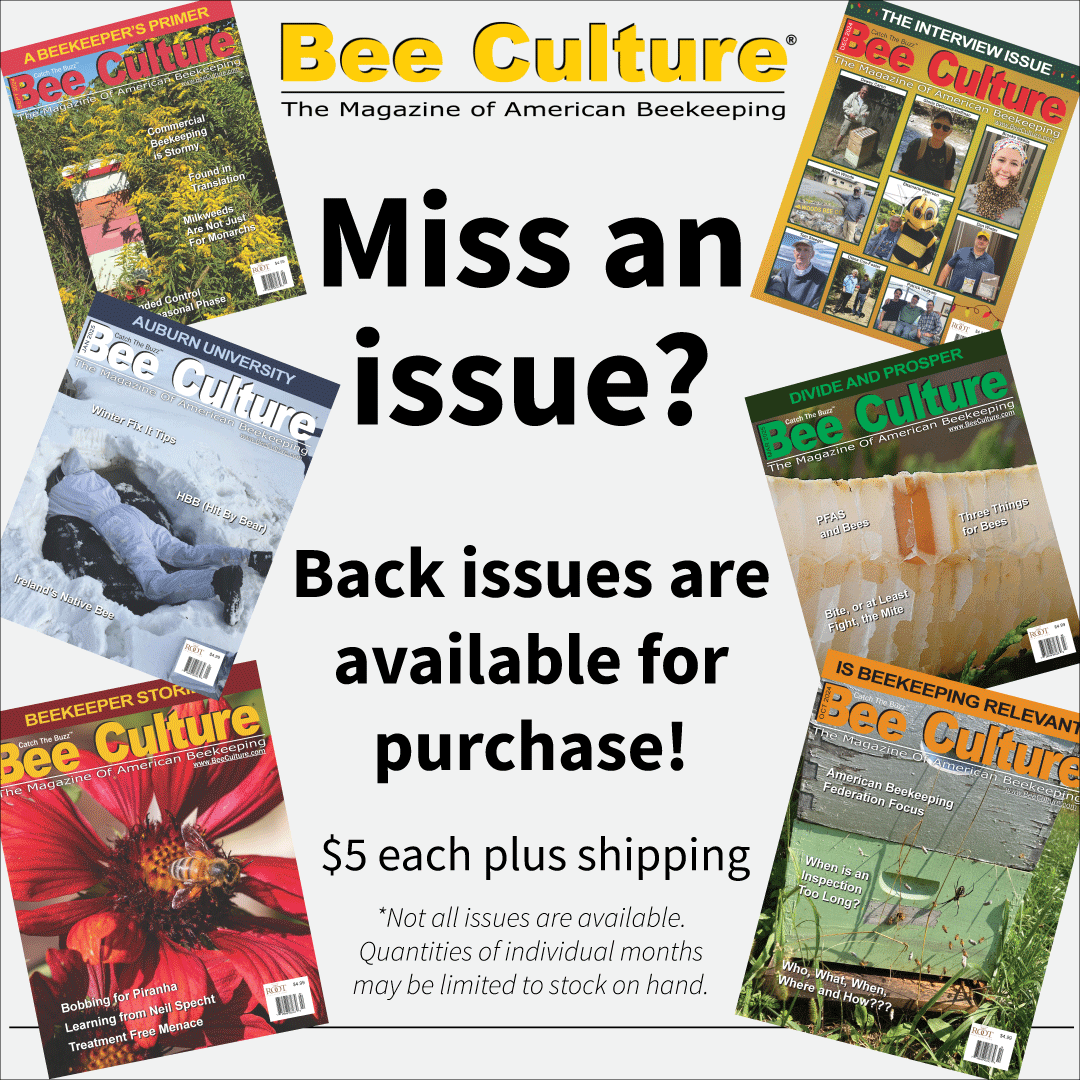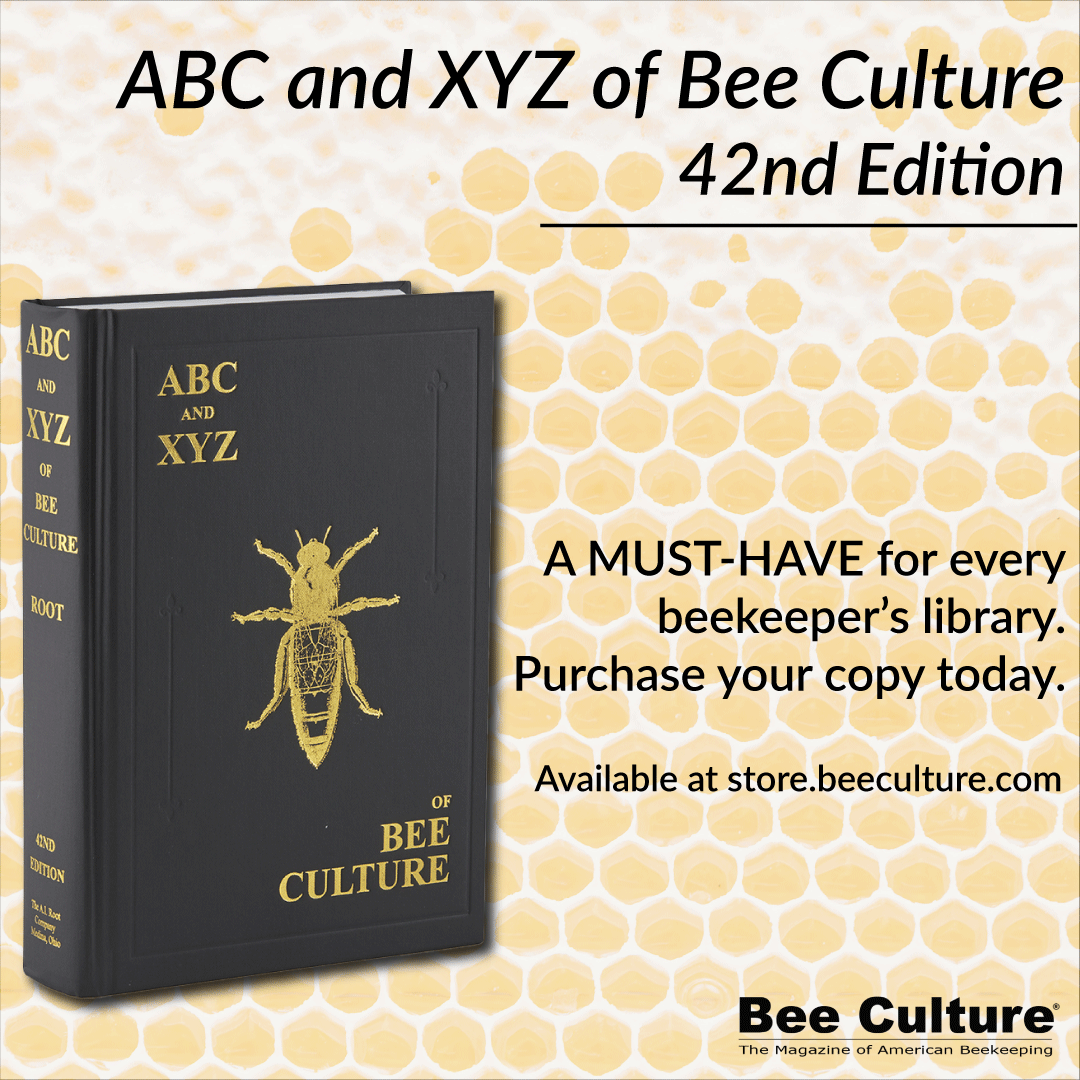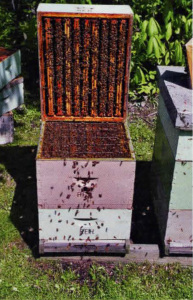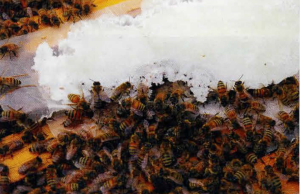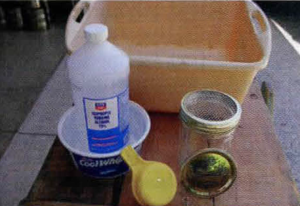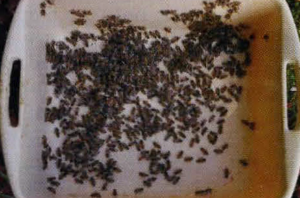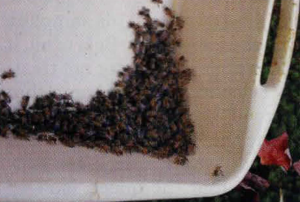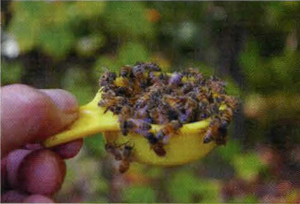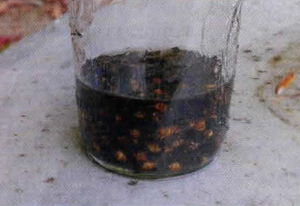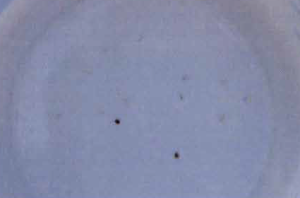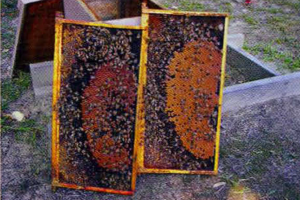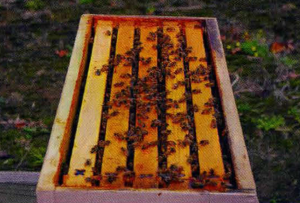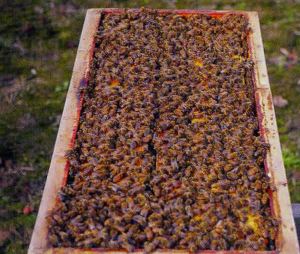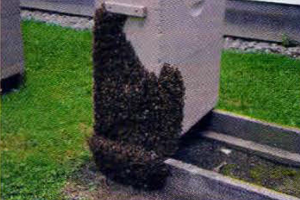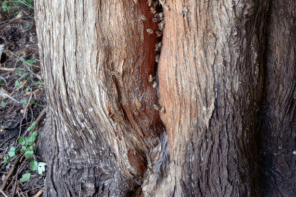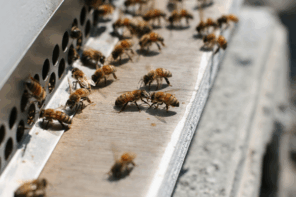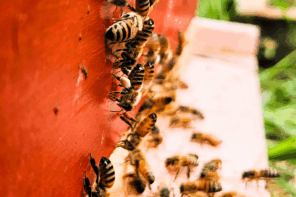By: Roy Hendrickson
Your first couple of years are full of learning and doing.
Year One:
Three Basic Startup Rules all New Beekeepers Should Heed
Rule 1: First of all, keep it simple. Beekeeping need not be complicated. Don’t let anyone lead you astray with complicated manipulations or their particular brand of specialized equipment. Once you become familiar with the basics, you can intelligently make your own decisions regarding colony manipulations, or what type of additional equipment you may require.
Rule 2: Don’t be afraid to open up your colony(s). It’s absolutely essential that you become comfortable when working around bees. I’ll use myself as the primary example. I started in 1974 (against my better judgment) by catching a couple of swarms nine days apart. It didn’t take more than a few days for the hook to set itself. I quickly determined that the only way to become a competent beekeeper was to practice, practice, practice and then practice some more. Consequently I was opening up my two colonies a minimum of three or four times a day! I shed my gloves in less than a week (too cumbersome). And I made a concentrated effort to relate what I was reading in my ABC and XYZ to what was going on inside my colonies.
That leads to Rule 3: Education. You have to educate yourself. Attending local club meetings or entering into a mentoring program is a good way to start, but it’s only a start. To really understand what’s going on inside a beehive, you have to read. Start with basic bee biology. Actually, bee biology is a continual study, but once you understand the basics move on to management techniques, swarm control and so forth. The mark of a competent beekeeper has nothing to do with how you handle prosperity; competency is defined by how well you react to adversity, and there will be plenty of that. Knowledge is everything!
The Internet
In today’s electronic world the internet has become the go-to information medium.
Although I lack any supporting data, I’m certain the vast majority of new or aspiring beekeepers use the internet as their primary information resource. While creditable information sources abound, generally speaking the internet is a morass of beekeeping information. For new beekeepers the real difficulty lies with their inability to separate fact from fiction.
I’ll cite the YouTube video as perhaps the best example of internet folly. Anyone with a cell phone and a bee veil can become an instant expert, and there is no shortage of candidates. Some of these charlatans are easy to spot, others are not. Beware of the self-proclaimed guru claiming years of experience, while offering counterintuitive advice on just about any topic imaginable. These individuals are quick to tell you how to keep bees, but they almost never give you any specifics as regards their beekeeping. The “you don’t have to treat for mites” crowd typifies this behavior. If you follow their advice you had better have deep pockets. Replacement bees are becoming quite expensive!
Steer clear of anyone offering to teach their system of beekeeping for a fee. If they claim some form of master beekeeper certification, run as fast as you can! The same holds true for anyone selling specialized equipment, feeding systems for example. lf you think you require additional equipment, check with the traditional bee supply houses. Better yet, seek the advice of one or more experienced local beekeepers. They’re in a position to advise you on the necessities required for your territory. Suffice to say, don’t fall victim to someone else’s fantasy. Spend the time and effort to learn beekeeping through time-tested, accredited sources.
The following are all excellent information resources. The Beekeepers Handbook by Diana Sammataro and Alphonse Avitabile, The Backyard Beekeeper by Kim Flottom, and Simple, Smart Beekeeping by Kirsten and Michael Traynor will all get you off to a great start. And by all means subscribe to a bee magazine, Bee Culture for example. It always amazes me that folks will spend hundreds or even thousands of dollars to start keeping bees, but they won’t spend twenty five bucks on a magazine to keep abreast of current events?
Foundation
Wax or plastic, which works best, and why? For brevity, I will explain the pros and cons of plastic foundation. Starting with frames, I much prefer wood frames over their plastic counterparts, primarily due to their greater rigidity and superior spacing advantage. I also prefer plastic snap-in foundation, particularly Pierco snap-in foundation. From a handling perspective, plastic foundation is far more durable and much easier to install than the wax alternative. In addition, plastic foundation is impervious to being “chewed up” during a nectar dearth or prolonged periods of inclement weather. This virtually eliminates the time and expense of replacing damaged or destroyed foundation! Perhaps the greatest advantage of plastic over wax is the absence of pesticide contamination. Recent studies indicate that brood combs generally contain a wide variety of both agricultural pesticides (insecticides and fungicides) and synthetic mite control residues. Rendered brood combs, i.e. beeswax that has been remanufactured into wax foundation retains many of the original contaminates or their breakdown constituents.
The only real disadvantage of plastic foundation is the increased weight. Ten sheets of deep, crimp wired foundation weigh a tad less than 1 ½ lbs. Ten sheets of deep, plastic foundation weigh slightly over 4 lbs, or roughly triple the weight of wax. While the weight difference is significant, it’s a relatively minor issue when compared to all the other advantages that plastic has to offer.
Year Two:
If you started keeping bees last year and your bees survived their first Winter, this article is directed specifically at you. There is a vast difference between your initial startup experience and the couple of years that follow. And as you have no doubt already learned, there is a wide array of options available to the new beekeeper. The purpose of this article is to explain or define a few of the operational basics. In time you’ll be able to select or adopt those ideas that best fit your beekeeping goals and the specifics of your operating territory.
The Second Year and Beyond
While your first venture into beekeeping was all about getting your colony(s) established, the second year is all about expansion. Barring the unexpected, your bee population is about to explode! The first order of business is to acquire and assemble any needed equipment. You can’t wait until the honeyflow starts to begin assembling supers. Follow that path and year number two will be long remembered as the year of the swarms.
Speaking of supers and such, not all equipment manufacturers build to the same specifications. For example, I’ve seen tolerances for hive body depth vary by a quarter inch or more. The depth of the rabbit or frame rest, and that of a deep frame can also vary considerably. Mix manufacturer A’s hive bodies with manufacturer B’s frames and you may end up with a major abuse of the Bee Space. For those who are unfamiliar, the Bee Space was the discovery by the Rev. L. L. Langstroth that made moveable frame beekeeping possible. Through patient observation Langstroth discovered that a separation of approximately one quarter to three eights of an inch prevented the bees from fastening everything together with either propolis or wax. The development of the moveable frame hive soon followed.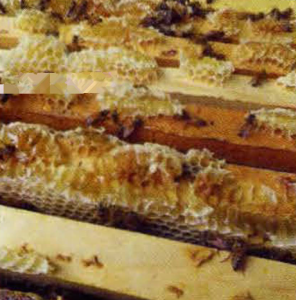
In practical terms most of the Bee Space abuses trend towards the excessive, i.e. the Bee Space is too large. I’ll cite two common examples. For manufacturing simplicity, virtually all commercial inner covers have a raised border on both sides. Regardless of which side is turned down, the resulting Bee Space is incorrect, often by as much as a quarter of an inch. Ever wonder why the bees build burr comb between the top bars and the inner cover? A more critical example was referenced above. When hive bodies and their corresponding brood frames aren’t in sync, the Bee Space abuse can turn deadly. The resulting burr comb, which is often filled with drone brood, is a potential death trap for queens. Every time you remove a brood frame or raise the upper brood box, you run the risk of crushing the queen upon reassembly. And 99.9% of the time you’ll never know anything is amiss. Be aware of the Bee Space.
Spring Management
In beekeeper lingo, Spring Management is the term used to loosely describe various methods of preparing one or more colonies for the honey flow. While the specifics can vary considerably from one area to another, there is a general theme or methodology to the Spring Management process. The following checklist explains the basics of Spring Management in chronological order.
The first order of business is to check the overwintered colony(s) food supply. This is easily accomplished by hefting the colony from one or both sides. If the colony appears light, some form of emergency feeding may be required. At the first opportunity open the colony and check the cluster location. If the cluster is located off to one side, that’s a clear indication the colony is short on
stores. In cold climates use a shim or deep rimmed inner cover and place a commercial Winter feed patty or home made wet sugar patty directly above the cluster. This should suffice until warmer
weather arrives. In warmer climates, center the cluster and feed 1:1 sugar syrup via the center hole in the inner cover. Colonies that are light on stores corning out of Winter should have their food reserve closely monitored until the onset of a recognized honey flow. (Refer below to the section on Feeding Bees)
The next step is to determine colony strength and queen condition. On the first sunny 60-65 degree day with minimal wind, simply observe the flight pattern between 10:00 am and 2:00 pm. (Don’t confuse normal flight with play flight, i.e. young bees marking the location of the hive prior to their commencement as foragers.) The larger the field force, the stronger the colony. Other than for emergency feeding purposes it’s not necessary to reopen the colony(s) until they have had a couple of weeks of warm weather to establish their broodnest.
Once I begin colony examinations I check for a variety of conditions. I start by quickly scanning the brood frames, particularly the capped brood. A solid brood pattern indicates that all is well, including the queen. While examining the brood frames I’m also on the lookout for any signs of disease, primarily AFB. I’m also watching for any sign of virus activity. Wingless bees, bees with shriveled wings, or young bees with stubby abdomens are all signs of trouble ahead. I also take particular note of the pollen band (stored pollen) above the brood and how much pollen is being stored in the active broodnest? I’ve never had to feed pollen substitute during the Spring buildup period, but I keep a wary eye nonetheless. I also note the amount and the age of the oldest drone brood. Drone brood is a sign of prosperity and is a general early season indicator of colony strength. Pay attention to the drone brood.
Next on the agenda is Varroa control. Regardless of your opinion on mite treatments, it’s a good idea to sample none the less. Absent treatment, a heavy mite load in early Spring will almost certainly spell disaster by the end of Summer. (Refer below to the section on Varroa Sampling and Control.) For a variety of reasons mite loads can increase dramatically anytime throughout the season. Therefore it’s a good idea to sample on a periodic basis. Colonies that enter the overwinter period with a heavy mite load rarely survive until Spring.
The next consideration, population management, is by far and away the most variable aspect of the Spring management equation. In order to produce a good crop of honey the broodnest must be full of bees, brood, and honey at the beginning of the main flow. Once the flow commences, the bees have no choice but to store any surplus up in the supers. To achieve this result you have to manage the colony so that the field force is approaching its maximum population by the start of the main honey flow.
The key or secret rests with the ability to project a colony’s growth rate and then act accordingly. Sounds complicated, but it’s really nothing more than common sense coupled with a little practice. There are two basic management options. You can either reduce a colony’s population in order to maintain the size of the existing broodnest (move the excess brood and adult bees to another colony, or make up a split), or you can increase the size of the brood nest by supplying additional drawn comb or foundation when necessary. When adding foundation in the absence of a nectar flow, it may be necessary to feed thin 1:1 syrup to stimulate the bees to produce new comb. (Refer below to the sections on Foundation and How to Make a Split.)
Early supering with drawn comb is the last major Spring management consideration. The addition of drawn comb above the broodnest has two distinct benefits. First, the supers provide storage space for any incoming nectar, anticipated or otherwise. Secondly, and just as important, they furnish a clustering or parking space for the legions of young adults that are emerging on a daily basis. In other words, early supering goes a long way towards alleviating or minimizing broodnest congestion, perhaps the single greatest contributor to the swarming impulse. I recommend the use of a queen excluder, preferably an all metal excluder, when supering with drawn comb. The excluder greatly simplifies colony management and crop removal. The queen is confined to the intended broodnest area, and the supers remain supers.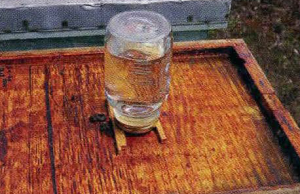
Never place full boxes of foundation directly. above a queen excluder. In most instances the excluder will act as a barrier. Then once the flow starts the broodnest fills with nectar, and swarm preparations are initiated. If you ‘re starting from scratch, omit the excluder until you have a couple supers of drawn comb. At flows end, run the queen down, install an excluder, and allow any brood to emerge prior to extracting.
Feeding Bees
From a practical standpoint, top feeding is by far the easiest and most efficient way for small beekeepers to feed. By top feeding I refer to the practice of feeding through the center hole in the inner cover. Feeding in this manner is both economical and extremely effective. The feed container can consist of whatever is handy. Quart Mason jars or plastic gallon jugs make excellent feeders. The rate of syrup consumption is controlled by the number of holes punched in the lid. The more holes, the greater the rate of consumption. Ideally the holes should be about 1/16th of an inch in diameter, or about the size of a standard frame nail. Use either 4 or 6D nail and a tack hammer, and tap the nail just hard enough to drive the point partially through the metal lid. With plastic lids, use the aforementioned 1/16th in diameter drill. When inverted over the inner cover, the feeder should be elevated about a quarter of an inch to allow the colony complete access to the feed holes. Use an empty super or hive body to protect the feeder from the elements. With this system, once feeding has commenced, it’s often possible to quickly replace or refill the feeder without the use of either a smoker or veil.
Cane or beet sugar, which works best? Both are sucrose, and they work equally well. Most of the big box wholesale stores tend to feature cane sugar, at least in my area. Cane sugar is always labeled as such; beet sugar is almost never specifically identified. If the bag or box just says sugar, it’s invariably beet sugar.
Syrup Formulas
Sugar syrup formulas are simply ratios of sugar mixed with water. In general there are two basic mixtures, thin syrup consisting of equal parts sugar and water, and thick syrup featuring a two to one ratio of sugar to water. Thin syrup is the basic Spring and Summer feed. It’s primarily used to stimulate early season brood rearing, and to allow the colony to maintain its strength through periods of nectar dearth. Heavy syrup is used to augment the Winter food supply, to prevent overwinter or early Spring starvation.
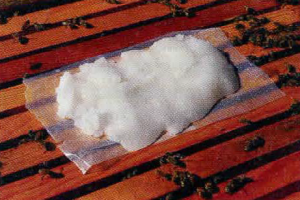 For small quantity mixing purposes, sugar and water are almost identical when compared on a weight to volume basis. For example, by volume a 4 lb (64oz) bag of sugar measures out to approximately 8- eight oz measuring cups. Fill that same eight oz measuring cup with water, the water also weighs about eight oz. Therefore a four lb bag of sugar when mixed with eight cups of water would yield roughly eight lbs of 1:1 syrup. The same bag when mixed with four cups of water would yield about six lbs of 2:1 syrup. For larger quantities simply convert water volume to a weight based mixing formula using eight lbs per gallon as the conversion ratio. For specific sugar weights and the compatible water volumes refer to the table below.
For small quantity mixing purposes, sugar and water are almost identical when compared on a weight to volume basis. For example, by volume a 4 lb (64oz) bag of sugar measures out to approximately 8- eight oz measuring cups. Fill that same eight oz measuring cup with water, the water also weighs about eight oz. Therefore a four lb bag of sugar when mixed with eight cups of water would yield roughly eight lbs of 1:1 syrup. The same bag when mixed with four cups of water would yield about six lbs of 2:1 syrup. For larger quantities simply convert water volume to a weight based mixing formula using eight lbs per gallon as the conversion ratio. For specific sugar weights and the compatible water volumes refer to the table below.
1:1 Mixtures:
8 lbs of sugar into 8 lbs or (1 gallon) of water
25 lbs of sugar into 25 lbs or (3 gallons + 1 pint) of water
2:1 Mixtures:
8 lbs of sugar into 4 lbs or (2 quarts or ½ gallon) of water 25 lbs sugar of into 12 ½ lbs or (1 gallon+ 2 quarts + 1 cup) of water
Depending on the amount of syrup required, the mixing vessel can be whatever is handy, a bowl or pot, a five gallon bucket, or for larger amounts, a 20 gallon garbage can. To mix any type of syrup, run the predetermined amount of hot tap water (130 to 145 degrees) into the mixing vessel, and then add in all the sugar before you start the mixing process. Stir intermittently until the
sugar is dissolved. No additional heat source should be necessary.
Emergency Feeding
Since early Spring weather patterns and the corresponding honey flows are relatively unpredictable, the potential for early season emergency feeding is always present. If possible, the simplest way to solve this problem is to transfer excess frames of honey from a neighboring colony. If there are no brood disease sugar patty issues, don’t be afraid to use the leftover honey from a Winter deadout. Colonies in weak to average condition should have at least one frame of feed honey placed adjacent to an outside frame of brood. Strong colonies should have frames of feed honey placed on both sides of the active broodnest.
Absent these options, there are two practical alternatives. The Winter feed patty, a concentrated sugar patty specifically designed for cold weather feeding. (Available through several bee supply outlets.) Some are straight sugar; others are a mixture of sugar and pollen substitute. For emergency feeding purposes, I would place the emphasis on the sugar only patty. The second option is a homemade wet sugar patty. Granulated sugar and cold water are the active ingredients. The basic formula is roughly 10 parts granulated sugar to 1 part cold water, by volume. Preparation consists of mixing the desired amount of sugar with just enough cold water to create a product that has the appearance of wet gravel. To feed, simply place the mixture on a sheet of waxed paper directly above the cluster. Use a deep rimmed inner cover or spacer rim to supply the necessary accommodation space. Within 24 to 36 hours the sugar will harden and the bees will use it exactly as they would the commercially prepared alternative. Once the weather warms into the 55-60 degree range you can revert to feeding sugar syrup as described above.
Varroa Sampling and Control
In today’s beekeeping world, Varroa has become public enemy number one. You either control Varroa or you perish! By control, I don’t mean that you treat as a precaution once the crop has been removed, or prior to Winter shutdown. If you practice that type of minimal Varroa control, you had better be prepared to purchase replacement packages or nucs the following Spring! In order to keep Varroa and its associated viruses in check, it’s imperative that the mite counts remain low throughout the season. The only way to maintain control is to sample on a periodic basis, and treat when mite counts exceed recommended levels.
- Materials required to perform an alcohol wash
- Shake the bees off a frame containing some older open brood, check for the queen
- Bounce the bees to one comer of the collection tub
- Scoop up one quarter cup of bees, ¼ cup equals approximately 150 bees
- Dump bees in wide mouth pint Mason jar and cover with alcohol
- Shake sample into a Cool Whip container, the current treatment threshold is 3 mites
There are a variety of sampling techniques to choose from. I would recommend an alcohol wash. This sampling technique is quick, accurate, and consistent. Best of all, it immediately allows you to determine whether or not treatment is necessary. Start by selecting a brood comb that contains some older open brood, brood within 24 hrs of being capped. This will provide the highest possible ratio of mites to adult bees. Check carefully to make sure that the queen isn’t on the selected frame. Hold the frame by an end bar and shake a portion of the bees into the collection container. A common eight-by-ten inch Rubbermaid dishwashing tub works exceedingly well. Once the bees have been shaken into the collection container, check again for the queen. Then tap the bees to one corner of the container and scoop up the desired number of bees. (A level ¼ cup equals approx 150 bees, 1/3 cup 200 bees, and 1/2 cup 300 bees). I prefer the 150 bee sample size; with the larger samples the additional bees act as a filter to inhibit mite shakeout. Whichever size you choose, dump the bees into a wide mouth pint Mason jar and install the outer ring fitted with an 8 mesh per inch screen. Tap the bees to the bottom of the jar and pour in enough 70% Isopropyl to cover the sample, and then install the solid center cover. Alcohol doesn’t immediately kill Varroa mites, so let the sample to sit for a minute or so before shaking. This will allow the mites’ time to extricate themselves from under the bee’s abdominal segments. When ready, shake the jar vigorously for 15 to 20 seconds. Now reverse the procedure and remove the center cover and replace the screened lid. For easy visibility I prefer to shake the sample into a Cool Whip container, but any light color container will work. Hold, or place the container on a solid level surface. Then with a single motion, invert and vigorously shake the sample jar up and down five or six times. The idea is to use the alcohol to assist in washing the mites out of the sample jar. Once the shake is complete, count the mites collected in the bottom of the container. Take care to count any mites adhering to the center cover or the inside wall of the jar. Currently the recommended treatment thresholds range from two to three mites per hundred bees sampled. Personally I would err on the side of caution and use the lower number. Translated, that means the treatment threshold for a 150 bee alcohol wash is three mites.
There are a variety of different mite treatments ranging from hard synthetics to softer organic products. I favor two of the softer organics, specifically Apiguard and Mite Away Quick Strips (MAQS). Both of these products are relatively easy to use, and both are effective mite control agents. Best of all, each of these products allows you to adjust the dosage based on colony size and the existing mite load.
Mite Away Quick Strips are my preferred form of mite control for full or medium strength colonies. There are two treatment options. The full treatment consists of two strips per colony containing six or more frames of bees. Under normal conditions this treatment should kill between 93 and 95% of the mites, including those under the brood cappings. However, under certain conditions two strips can cause varying degrees of brood damage, especially on smaller colonies. Consequently I’ve switched to the alternate half treatment, or one strip per colony of the same size. This treatment is somewhat less effective, probably eliminating somewhere between 50 to 60% of the mites. To offset the reduced efficacy l treat every three of four weeks depending on the existing mite load. Regardless of treatment size, follow label instructions for handling requirements and temperature tolerances.
Apiguard is a thymol gel marketed in a 50 gram peel off tray for individual colony treatment, or in a 6.6 lb bucket for multiple colony treatment. The recommended dosage is 50 grams per colony, repeated at two or three week intervals. As with Mite Away, the full strength dose can cause varying degrees of brood damage. However, a 25 gram half dose appears to be nearly as effective, with minimal brood loss. Treatment application can be achieved a couple of different ways. For those with only a few colonies simply divide the contents of a 50 gram tray in half. Use a hive tool or small spatula to remove and place each portion on a two inch square piece of waxed paper (dry wax paper works best). Don’t spread the gel, leave it in a clump and center the treatment on the top bars between brood boxes. If you’re treating a nuc or a single hive body colony, use a spacer or deep rimmed inner cover to provide the necessary accommodation space. For multiple colony treatment remove 25 gram dose from the bucket, (weigh or estimate the volume) and apply in the manner described above. I prefer this product for nucs and small colonies not quite strong enough to tolerate MAQS. Always Read Labels.
How to Make a Split
Splitting or dividing colonies is one of the basic tenants of beekeeping. It’s the means by which you replace your losses, expand the size of your apiary, or manage the size of your established colony(s). (Read swarm control.) While there are numerous variations on the splitting procedure, the basic idea is to remove excess brood and adult bees from one or more donor colony(s), and then supply the new colony with either a caged queen or mature queen cell. Once the queen has been accepted, the split herein referred to as a nuc, can be allowed to grow at a normal rate. It can
be used to requeen a failing colony, or brood and bees can be added to increase the rate of buildup in order to produce a crop of honey. On the other side of the equation, the swarming potential of one or more donor colony(s) is reduced, thereby increasing their chances of producing a profitable crop of honey.
As with any beekeeping function, there isn’t a single ‘best way” to make up a split. Due to abundant mild weather, southern or middle latitude beekeepers more or less have free reign. Almost any system or equipment variation will work. Cold weather limits the choices for those operating in more northern locations. Since my beekeeping is confined to a cold weather environment, I’ll describe my split makeup procedures. Adjust as you deem appropriate.
My current practice is to start splits in five frame nuc boxes. Each split is started with two frames of brood and plenty of extra bees. A frame of honey and two empty combs round out the unit. A caged queen or mature queen cell is installed once the unit has been moved to a new location. Starting the splits in nuc boxes has several advantages over standard ten frame equipment. The smaller nuc box traps or confines a portion of the heat given off by the cluster. This allows the young queen to expand her broodnest at a much faster rate than would be possible in a ten frame box.
Once brood from the new queen starts to emerge, the colony will immediately require additional comb space. This is a prime example of a relatively weak colony that will readily draw foundation. If you’re in need of more drawn comb, simply add a second five frame box of foundation directly above the established broodnest. If there is a honey flow in progress, you’re all set. If not, you’ll have to feed 1:1 syrup until the flow begins. By the time the foundation has been drawn out, the season will have progressed to the point where you can safely transfer the nuc into standard equipment.
Comb Production Tip – Any colony will draw new comb at a much faster rate if it’s able to keep the comb production area warm. Heat rises, so whenever possible place foundation directly above the active broodnest. Brood comb produced in this manner will generally be vastly superior to that produced within the actual broodnest. The lower brood box, the box setting on the bottom board, is the very worst place to put foundation. When you see a brood comb with open corners or a gap between the bottom of the comb and the bottom bar, rest assured, that comb originated in a lower brood box.
How to Avoid Transferring the Queen When Making Splits
Locating queens is probably the most vexing problem beekeepers face. Factor in a lack of experience, and the problem is magnified a hundred fold. The following is a sure-fire method of not removing the queen(s) from one or more donor colonies preparatory to making a split. You’ll need three pieces of equipment, a temporary holding box, (a nuc box is ideal) a queen excluder, and an extra hive body.
In practice, select a brood frame that you’re going to use to start the split and gently shake a portion of the bees back into the parent colony. (Shake off just enough bees so that you’re sure the queen isn’t present.) Place the frame into the nuc box and repeat the process as needed. Once the startup frames are set aside, remove two or three additional frames of partialy capped brood and repeat the shake-off process. These frames are going to supply the additional nurse bees necessary to jump start the new split. All total you should end up with four or five frames in the nuc box. Now place the queen excluder and extra hive body on top of the open colony. The final step is to transfer all of the shaken frames from the nuc box back into the empty hive body above the excluder. Close up the colony and find another activity for the next two or three hours. In your absence, young nurse bees will traverse the excluder and repopulate the brood frames above. The queen, unable to pass through the excluder will remain in the lower brood boxes going about business as usual.
Upon your return, transfer the two selected startup brood frames plus the adhering bees into their new abode. The last step is to shake the nurse bees off the frames of partially capped brood. Once shaken, return these frames to the original broodnest. If possible, replace the two startup frames with drawn comb; otherwise add frames of foundation to the outside of the uppermost brood box. The nuc is now ready to be moved to a temporary location at least a mile away. This will prevent any of the nurse bees from returning to the parent colony. Upon arrival, install either a caged queen or mature queen cell.





